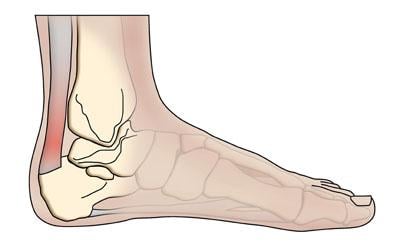Achilles Tendonitis Treatment, Symptoms, Causes and Prevention
Achilles Tendon
Tendons are thick, fibrous cords that attach muscle to bone. The Achilles tendon, also called the heel cord, connects muscles in the back of the lower leg to the heel bone (or the calcaneus). It helps the foot point downward, rise up on the toes and push during walking. The Achilles tendon was named after Achilles, a mythological Greek warrior whose mother held him by the heel and dipped him into the Styx River with the hope of giving him immortality.
What is Achilles Tendonitis?
Inflammation of a tendon is called tendonitis, and inflammation or irritation of the Achilles Tendon is referred to as Achilles Tendonitis.

Symptoms
Symptoms include pain, tenderness and stiffness just above the heel bone.
Causes
The most common cause is overuse of the tendon, such as during excessive physical activity involving feet and repetitive stress. Biomechanical abnormalities and wearing high-heeled shoes for prolonged periods can also create this condition.
Prevention
Stop, or at least limit, activities that place excessive stress on tendons. For example, if running causes Achilles tendon pain due to the high-impact motion, then cross train by mixing in a lower-impact activities such as biking or swimming. It is also very important to stretch before and after such activities to prevent damage to the tendon.
Treatment
To treat Achilles tendonitis, remember the acronym "PRICE": protect, rest, ice, compress and elevate:
-
Protect: Protect from further injury by immobilizing it.
-
Rest: Rest is vital for tissue healing. Avoid activities that increase pain or swelling to the injury. After a few days of completely resting the affected area, gently move it through its full range of motion a few times a day to maintain joint flexibility and prevent stiffness.
-
Ice: Ice can help reduce tendon pain or swelling. Apply it to the injured area for about five minutes a few times daily.
-
Compress: Compress the injury until the swelling is gone with a compression bandage or wrap.
Wearing a Pedi-Smart® Compression Anklet and using crutches can encourage faster healing.
-
Elevate: Elevate your foot above the level of your heart to reduce swelling.
Wearing proper footwear and shoe inserts, such as PediFix® heel stabilizers and heel supports, can take stress off of your tendons, comfort feet and prevent injuries.
Links to recommended PediFix® Products:





